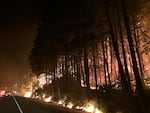
Fire crews battling the Eagle Creek Fire perform a back burn of fuel near Interstate 84 West on Sept. 8, 2017.
U.S. Forest Service
As the smoke settles, people are asking how to heal the Northwest’s forests. What’s to be done with the blackened trees, spread across hillsides?
One sore spot for people is the Columbia River Gorge.
In an effort to help rehabilitate the land, U.S. Rep. Greg Walden, R-Ore., has introduced a bill that would expedite a controversial logging practice in the National Scenic Area: salvage logging.
The goal is to quickly log wildfire-burned trees in an attempt to make a few remaining dollars off what’s left of the timber before it starts to decompose and becomes a host to fungi or insects.
"What we're trying to do here is clear the bureaucratic decks so that the professionals can do their job and do it quicker," Walden said at a press conference Saturday that OPB reported on.
"This can all be done following all the environmental laws, but we've gotta streamline the timelines — we have to get at work here as soon as the flames are out and the basic work is done," he said.
The salvaged timber collected could be used to help pay for restoration efforts, Walden said.
Salvage logging proponents also say it gets rid of what would one day become more dead wood — fire fuel.
Walden was unavailble to speak Tuesday about his bill, and text for the bill has not be provided.
According to his press office, the bill would:
- Require the Forest Service to develop a cleanup and reforestation plan 30-days after the Eagle Creek Fire is contained
- Provide a fast-track rehabilitation for “priority areas” and
- Require the Forest Service to replant burned areas within two years.
But environmental groups said there are a lot of problems.
Salvage logging machinery can track in unwanted plants — a bad prospect, groups said, for rare native plants already scarred by fire. Heavy machinery could damage soils. And those standing dead trees are important features in an ecosystem, providing habitat for woodpeckers and other wildlife.
“This is a federal National Scenic Area and the Mark O. Hatfield Wilderness Area,” said Michael Lang, conservation director with Friends of the Columbia Gorge. “Both of those federal laws have prohibitions to what Congressman Walden is discussing.”
It’s too quick of a decision, Lang said — too much is still unknown about what actually has burned.
“The preliminary reports that we have is that this is a fire that jumped and spotted quite a bit. It’s not a scorched-earth landscape in the gorge,” Lang said.
The better forests are managed before a wildfire, the less work is needed after one, said Reese Lolley, director of forest restoration and fire at The Nature Conservancy, Washington.
“The more preparation we do in our communities and in our forests before — in the sense of forest restoration, forest health work — that puts us in a better position, puts firefighters in a better position, puts communities in a better position during the fire to have better outcomes,” Lolley said.
A recent study by the Forest Service found salvage logging might not have much effect on plants.
In 2002, a fire burned through the Lassen National Forest in Northern California. Researchers set up plots that had different amounts of post-fire logging, from unsalvaged to 100 percent salvaged.
They monitored the plots from 2006-2012.
“Our results indicated that understory vegetation change 4–10 years post high-severity wildfire appeared to be influenced more strongly by factors other than salvage logging,” the study authors wrote.
The authors wrote that while the findings support a “growing body of evidence,” they aren’t universal because of the way the logging was done and the specifics of the site, mostly ponderosa pine trees on relatively flat ground with more rocky soils.
A different landscape from the Columbia River Gorge, Lang said. This part of the gorge is steep; there aren't roads; it's not appropriate for traditional forest management, he said.
“For more than 100 years we have protected this region from logging. It has experienced wildfire in the past and will in the future. Salvage logging can be very destructive and has no place on public lands in the Columbia River Gorge National Scenic Area or the Hatfield Wilderness Area,” Lang said.
